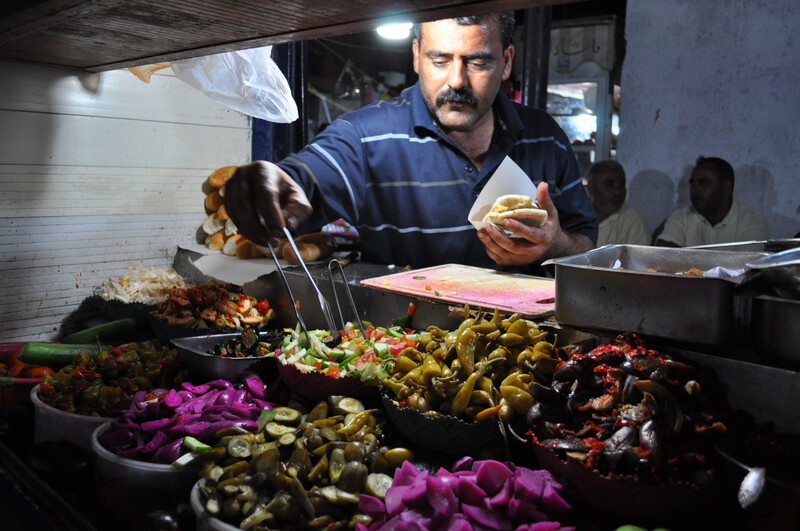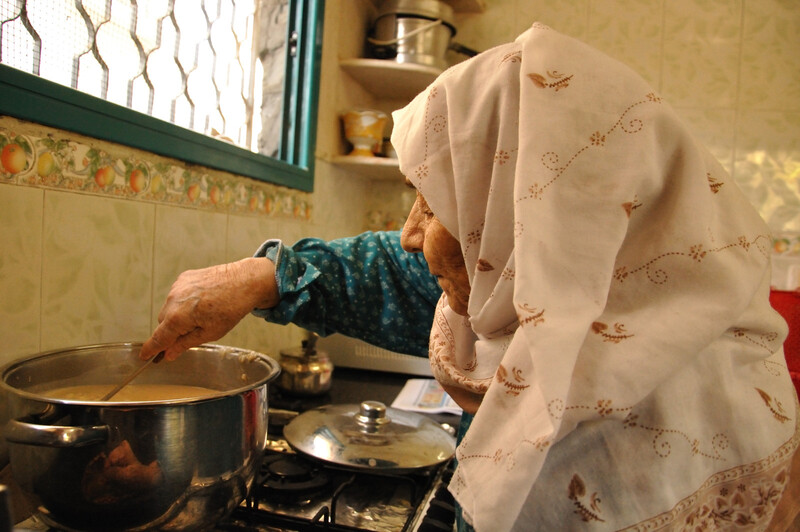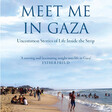The Electronic Intifada New York City 30 January 2013

A street vendor prepares a sandwich with an array of salads and pickles by the light of a camping gas lantern during one of Gaza’s frequent power outages.
The Gaza Kitchen, a new book by Laila El-Haddad and Maggie Schmitt, challenges the pervasive image of Gaza as destitute, war-torn and bereft of any possibility of a vibrant culture.
There is the blockade, the siege and bombardments the Gaza Strip has had to (and continues to) endure. But most Gazans are ready to brag about the beauty of the land and seascape, the local culture pulsating with ingenuity despite the harsh living conditions and — with perhaps the most pride — the cuisine.
Outside of Gaza, there is little awareness of its abundant fresh fruits and vegetables — including an array of wild greens used frequently in local dishes — as well as the seafood, the different flavors and the generous use of spices (including Gaza’s infamous hot chili peppers).
These are but a few of the treats from this largely unknown and misunderstood jewel on the Mediterranean that El-Haddad, a journalist from Gaza living in the US (and author of the popular Gaza Mom blog), and Schmitt, a US anthropologist living in Spain, honor in The Gaza Kitchen.
Hadeel Assali interviewed El-Haddad and Schmitt by Skype earlier this month for The Electronic Intifada.

Rumaniyya is a surprising dish unique to the Gaza area. Made with sour pomegranate, eggplant and lentils, it is a much-loved harbinger of autumn.
Hadeel Assali: First question, so we can get it out of the way: where is the rumanniyah recipe? Rumanniyah, a seasonal specialty, is a vegetarian stew made with a sour variety of pomegranates, lentils, eggplant and tahini. A strange but absolutely delicious combination.
Laila El-Haddad: It was somehow inadvertently left out of the soft-cover copy, but it will be in the hardcover version. The recipes we collected in Gaza will be available shortly on the website www.gazakitchen.com.
HA: How was this project conceived?
LE: It’s something I’ve always wanted to do but I was never really sure where to begin or how to make it happen. I first wrote about the cuisine of Gaza for an issue of This Week in Palestine a few years ago. It occurred to me back then that there had never been anything exclusively written on the subject, and very little on Palestinian food in general. Since that time, Google searches for Gaza food would result in my article. That is how Maggie found me.
Maggie Schmitt: Food is a great entry point for talking about deeper social issues such as the siege on Gaza. It is political, it is interesting, and this seemed like an especially good moment for such an approach since food is such a trendy topic in the US.
My first time in Gaza was with a CodePink delegation after Cast Lead in May-June of 2009. Later, I was doing research for an article I was writing on Gazan food history, and the only things I found were Laila’s article and blog posts. I contacted Laila, and later my article, which was published in The Atlantic, was very well-received and even went viral (“In Gaza, Eating Under Siege,” 1 July 2009).
We realized we were onto something, an approach people were very responsive to, and so we kept writing to each other about our ideas. I was interested in looking at food systems, food economy, the question of water, land access and the social aspects of it. Laila had always dreamed of doing a Gaza cookbook because it is a different and unknown cuisine. She was also interested in doing heritage collecting and archiving of the recipes and their variations.
LE: We wrote up a project together without having ever met each other, and began looking for sponsors and funding. Due to the blockade, the biggest challenge was getting into Gaza. At one point, the Egyptians opened the Rafah crossing temporarily. I called Maggie and told her I was heading to Gaza. Unlike previous attempts, I got in immediately, but Maggie had to wait in Cairo for two weeks before finally making it through. We met for the first time in Gaza City. It was a hot summer, and I was fasting for Ramadan for about 16 hours a day, and had my two children with me, but we hit the ground running.
MS: People were so excited to talk about food. Journalists are usually interested in talking about politics, borders, war and so forth, but instead we were [telling] them, “No, no, we just want to know how your grandmother made lentils.” They were thrilled! So many people invited us into their homes to show us this or that … it was a wonderful kind of fieldwork to do.
HA: It is a very ethnographic project, one that uses the recipes as story-telling mechanisms. Can you talk about the format of the book?
MS: For me, doing the portraits and using food as an ethnographic point of departure was really what was most exciting about this project. It was a great methodological possibility; in the end, I feel the book does less of that than I wanted. I wanted it to be a bigger book with more space for this approach, but the publishing constraints had us squeeze it down to a minimum.
Highlighting daily life and the quotidian as the place where culture happens, where politics happen, where people’s life-worlds take on meaning — and looking at the kitchen as an epicenter for all of those things, as a place where economy and official politics run up against the stories people tell about themselves — was really at the heart of what this book was about.

Um Ibrahim, 86, prepares the kishk stew characteristic of her home village Beit Tima, destroyed in 1948, while reminiscing about village life.
HA: With this project, you managed to enter into more women’s spaces, which is a very private sphere in this part of the world. As you clearly demonstrate in the book, one cannot help but capture certain kinds of stories during conversations about recipes and food. In some of the vignettes, you captured themes that are for many, rather difficult terrain — for example, Arab and Muslim women’s issues, especially when presented to a Western audience. How did you navigate this?
MS: When you’re talking about politics and borders and “official business,” hugely your interlocutors are men. But when you’re talking about food, the authority is always somebody’s grandmother. So you do indeed enter into more women’s spaces.
LE: The book’s purpose is not to do a survey of women in Gaza. That just happens to be one of the results. We don’t really talk to the younger generations who make up half of Gaza’s population, for example. Palestinian women have the highest literacy rates in the Arab world, but we don’t get into that. We tried to take things for what they are, in their natural context, and not make them something else or self-censor or editorialize in any way. We tried to tell stories about individuals based on their own backgrounds and contextualize that background rather than to use our own values as a barometer.
Once you are given access to different spaces, you begin to see beyond these broad generalizations and reductionist views you might have on how women live in Gaza. You go into the households, for example, where the gender roles are not as you would expect — the men doing the cooking or the babysitting, the women working. I was taken aback. It made me confront my own biases and generalizations about how women live and what patriarchy looks like.
Things change and continue to change as Gazans have to learn to adapt to the hardships of the economic and social realities, even considering it is an enclosed territory that has not had exposure and interactions with the rest of Palestine. Things just aren’t as dynamic when you’re not interacting with other people.
HA: That is a great entry point for discussing what cannot get in (or out) as a result of the siege. Certain things cannot be exported, and certain food aids are imported. The very presence of food aid opens the question of the impact of the siege on not just Gazan lives, but the recipes as well, and you discuss this in your book. Some have talked about the impact of the siege from a public health perspective on the nutritional health of the population. Can you talk a bit about how the siege has impacted recipes?
LE: One example of the effects of the blockade is the price of vegetables that are for export, like tomatoes and cucumbers, which in better times are exported to the West Bank. When they are not exported, they are dumped on the local market and the price plummets. In the West Bank, when they are not available, the prices sky rocket.
Also, there are many food items specific to Gaza that are unfamiliar to other Palestinians. For example, no one in the West Bank knows ein jarada (dill seed). A lot of this has to do with the decades-long Israeli enforced separation between the two areas.

Fiery filfil mat’houn (or shatta) is a key ingredient in many Gazan recipes. It is produced locally with Gazan chili peppers and sold in vats at the market.
MS: Like Laila said, there is the question of vegetables and things for export and their over-availability when they suddenly can’t be exported. There are also all of the things that were habitually imported, and with the siege, some things enter, some things don’t — it is very volatile. For example, whenever Israeli agriculture has overproduced some product, they will dump it on Gaza in order to clear out the Israeli market, which is awash in whatever that product is. So things come and go in a very unpredictable way, and people cook on the basis of what they are finding affordable at the market, and that is a very unpredictable thing.
The most unpredictable element is meat. During Cast Lead [Israel’s winter 2008-09 attacks on Gaza], for example, nearly all the chickens were killed because either the chicken farms were bombed or electricity shortages prevented heating the surviving chicken farms to keep the chicks warm, so consequently there was a major chicken shortage.
Also, as in the case of food aid, only processed wheat in the form of white flour is entering Gaza, not the wholesome grains Palestinians had been cultivating and incorporating into their cuisines for years before.
HA: It is great that you put the zibdeyah [Gaza-made clay mortar and pestle] at the beginning of the book; it is essentially the holy grail of the Gaza kitchen. Perhaps you can talk about this and offer suggestions for alternatives for those who don’t have access to this very specific kitchen tool.
LE: I had mentioned substitutes in the book, but because of publishing space constraints, they had to be removed. I suggested the Mexican molcajete and perhaps an even better substitute is the clay Thai mortar and pestle. Most important is for people to know is the metal and marble ones do not work the same. The wider the base, the better.
MS: What is interesting about it is how much its use is at the heart of the way people cook. The object itself is, from my perspective, one more consumer object, but it becomes beautiful because people use it so much and love it so much and it becomes somehow part of the family — but not as the object itself. I wrote about it before on another website, and many people kept asking how to get one. But the whole point was the borders are closed and you can’t get one!
HA: Although it’s probably the last thing you want to think about until this project is over and the book is actually out, what is next?
LE: We would love to expand this into a wider assessment of Palestinian cuisine and do a really broad sweep of Palestine looking at the particularities of foods in the different [refugee] camps in Lebanon and Jordan, the Palestinians in the Gulf, following how the food traditions transform throughout the diaspora and then feed back to Palestine — the give and take of how traditions get interpreted. Palestine: a culinary journey, perhaps?
The paperback of The Gaza Kitchen is available from Just World Books and a hardcover is available now for pre-order for $43.
Hadeel Assali is a graduate student in anthropology based in New York City.

